Writing Advice:
Dr Len Rogers PhD, MSc, MBA, BA, Dip Mkt, FIoD describes how to use quotation marks and inverted commas correctly, with easy-to-understand examples
Quick links on this page:
I first "met" Len via email. We chatted about short story competitions, and he sent me some of his articles and papers. Many of them are about writing and grammar. I asked him if I could publish his post about comma usage. As you will see from the link, Len kindly said yes.
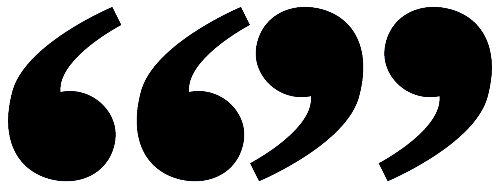
Len's comma advice was well received by my audience. So, Len sent me another paper about quote marks / inverted commas. These are often misused by writers, especially when presenting dialogue / speech, and cause a lot of confusion. This post deals with all of that, and more.
As always, comments are welcome. You can find the comments form at the bottom of this page.
Turn commas upside down for inverted commas, which are used as quotation marks in America. Then there are single and double quotes and straight or curly commas. This can be confusing for writers. Here is my advice, using examples.
Quotation marks ― inverted commas in America ― can be written by hand, typed or printed. They can be curved or straight, single or double, but if you are writing on a computer, you can adjust settings to print them straight or curved.
As occasionally there are single and double quotes in the same sentence, you can print both single and double quotes straight or curly. If you choose straight, the commas are identical, just simple, vertical inverted single or double quotes. If you choose curly ― called ‘smart’ quotes ― opening quotes are left-hand curved and closing quotes are right-hand curved.
Here is how to adjust the settings on your computer for quotation marks: Start by clicking File top left-hand corner of the screen then:
File>Options>Proofing>AutoCorrect Options>AutoFormat As You Type,
and check the box at the side of “Straight quotes” with “Smart Quotes”.
American style uses double quotes (“double”) for direct speech / dialogue and single quotes (‘single’) for quotations within a quotation.
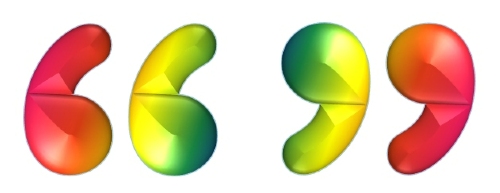
Example of American style:
“Punctuation, and spaces between words,” according to style guides, “is a development of ‘silent reading,’ a practice that began in the 10th century.” [note ― period quotation]
British style uses single quotes (‘single’) for direct speech / dialogue and double quotes (“double”) for quotations within quotations.
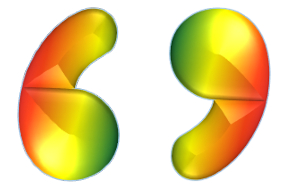
Example of British style:
‘Punctuation, and spaces between words,’ according to style guides, ‘is a development of “silent reading”, a practice that began in the 10th century.’ [note ― period quotation]
Note also that the American style places commas and periods (full stops) inside the quotation marks, even if they are not in the original material. British style, more logically, places unquoted full stops and commas outside the quotation marks.
For all other punctuation, British and American styles are similar, unless the punctuation is part of the quoted material, it goes outside the quotation mark. Except, both styles end a sentence with punctuation (period) and then a quotation mark. There is more on this complex and admittedly confusing topic in this paper.
The main use of quotation marks is to enclose direct quotations ― someone’s exact words. Anything that is not a direct quote, that is, not what a person said, is placed outside the quotes. In printed matter, British usage prefers single quotes and although you might use double quotation marks for conversations and direct speech in your MS (manuscript) the British printer will convert them to single quotes. Just to confuse matters, American usage insists on double-quotes.
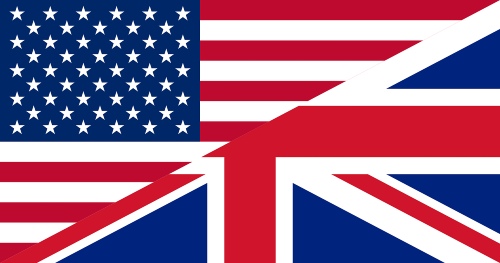
International usage varies but tends to follow the British style. For students, studying in “the West”, which may be in the USA or Europe, be guided by what your tutor, supervisor, editor, or publisher requires.
The overriding rule is all punctuation signs used with words in quotation marks must be placed according to the sense. If a quotation or extract ends with a punctuation ― full stop (period), exclamation, or interrogation point (question mark) ― that punctuation must be inserted before the closing quotation mark. This means that question marks and exclamation marks sometimes precede and sometimes follow quotation marks depending on whether their application refers only to the words quoted or to the whole sentence of which they form a part.
However, in any construction, the sentence full stop is omitted after a question mark or exclamation mark. When a comma, semicolon, colon, or full stop is required at the end of a quotation, it should not be included in the closing quotation marks. Place full stops, commas, et cetera, according to the following examples.
Our subject is the Cambrian period known as ‘Early Palaeozoic’.
The two words Early Palaeozoic do not form a sentence and cannot have a full stop belonging to them: the full stop belongs to the whole sentence and is placed outside the closing quote, and not within.
Thus, ‘Early Palaeozoic’. [quote period] ✔ ‘Early Palaeozoic.’ [period quote] ❌
The following 16 sentences are two sets of 8. The first set, (1 to 8) uses double quotes, and the second set, (9 to 16) uses single quotes. All 16 sentences repeat the same statement about man’s character. The words said Heraclitus, add information and in eight of the sentences interrupt the statement breaking it into two.
1. “A man’s character is his guardian divinity, said Heraclitus.” [period quote] ❌
2. “A man’s character is his guardian divinity, said Heraclitus”. [quote period] ❌
3. “A man’s character is his guardian divinity,” said Heraclitus. [divinity comma quote]
4. “A man’s character is his guardian divinity”, said Heraclitus. [divinity quote comma]
5. “A man’s character”, said Heraclitus, “is his guardian divinity.” [character quote comma]
6. “A man’s character,” said Heraclitus, “is his guardian divinity.” [character comma quote]
7. “A man’s character”, said Heraclitus, “is his guardian divinity”. [quote period] ❌
8. “A man’s character”, said Heraclitus, “is his guardian divinity.” [period quote]
9. ‘A man’s character is his guardian divinity, said Heraclitus.’ [period quote] ❌
10. ‘A man’s character is his guardian divinity, said Heraclitus’. [quote period] ❌
11. ‘A man’s character is his guardian divinity,’ said Heraclitus. [divinity comma quote]
12. ‘A man’s character is his guardian divinity’, said Heraclitus. [divinity quote comma]
13. ‘A man’s character’, said Heraclitus, ‘is his guardian divinity.’ [character quote comma]
14. ‘A man’s character,’ said Heraclitus, ‘is his guardian divinity.’ [character comma quote]
15. ‘A man’s character’, said Heraclitus, ‘is his guardian divinity’. [quote period] ❌
16. ‘A man’s character’, said Heraclitus, ‘is his guardian divinity.’ [period quote]
Clearly, sentences 1 & 2, and 9 & 10 are wrong because they have enclosed the words said Heraclitus within the quotation marks, but Heraclitus did not say “said Heraclitus.”
Consider sentences 3 & 11 and 4 & 12.
[The four sentences are reproduced here for ease of reference.]
3. “A man’s character is his guardian divinity,” said Heraclitus. [divinity comma quote]
11. ‘A man’s character is his guardian divinity,’ said Heraclitus. [divinity comma quote]
4. “A man’s character is his guardian divinity”, said Heraclitus. [divinity quote comma]
12. ‘A man’s character is his guardian divinity’, said Heraclitus. [divinity quote comma]
Consider the punctuation of the comma after divinity in the statement: A man’s character is his guardian divinity, ― does that comma belong to the statement about a man’s character?
If it does, then the logical view is that it goes inside of the quote and 3 and 11 are correct.
If the comma, after divinity, does not belong to the statement, the logical view is that the punctuation (comma) goes outside of the quotation mark and 4 and 12 are correct.
Consider sentences 5 & 13, which have the same order: punctuation (comma) outside of quote, and sentences 6 & 14 which have punctuation (comma) inside of quote. [Here they are again for ease of reference:]
5. “A man’s character”, said Heraclitus, “is his guardian divinity”. [quote comma]
13. ‘A man’s character’, said Heraclitus, ‘is his guardian divinity’. [quote comma]
6. “A man’s character,” said Heraclitus, “is his guardian divinity.” [comma quote] ❌
14. ‘A man’s character,’ said Heraclitus, ‘is his guardian divinity.’ [comma quote] ❌
Applying the rule, we could say that the comma after the word character sets off the weak interruption “said Heraclitus” and it is not part of the quotation. Therefore, the quotes should be outside of the punctuation mark, and 5 & 13 are logically correct.
And here is where we arrive at an illogical convention that contradicts the usual principles of punctuation, a style that has become universal in English and causes problems for students and writers alike.
6 & 14 are how they will be printed ― comma or full stop inside the quotation mark.

For the remainder of the sentences, we will use the conventional style instead of the logical style, and the final full stop is always inside the closing quote. Thus, by convention, sentences 2, 7, 10 & 15 above are not acceptable.
So, use quotation marks logically, do not put them around anything other than word-for-word quotation but, follow convention. The following is wrong:
The passage inside the quotes does not reproduce Einstein’s exact words. There are three ways to deal with this. First, lose the quotes:
Second, rewrite using Einstein’s exact words:
Third, move the quotes so that they enclose only Einstein’s exact words:
You can, of course, use single quotes instead of double quotes; this is a matter of preference or US convention.
Note that all these quotations are set off only by quotation marks and nothing else. Here are some common mistakes:
In the first, the colon is pointless while in the second, a colon is never followed by a dash (although it used to be taught in school years ago).
Preferred style:
This sentence is clear ― grammatically ― although its sentiments may be arguable. Punctuation marks should not be used if they are not necessary although many people insert a comma before an opening quote:
President Trump declared, ‘I did not lie.’ ✔ (optional comma)
While a comma before direct speech is not necessary as it does not work in the sentence, many copy editors and publishers insist on it being used.
The logical view holds that the only punctuation marks that should be placed inside the quotation marks are those that form part of the quotation itself, while all others should be placed outside.
The conventional view, in contrast, insists on placing most other punctuation marks inside a closing quote, regardless of whether they form part of the quotation or not.
Here are three sentences punctuated according to the logical view ― none is acceptable.
Here they are punctuated according to the conventional view ― all three are acceptable.
English punctuation does not always follow a rigid set of rules but is used according to convention. Before you start writing, I advise you to set your computer to the quotation marks style you intend to adopt.
First, decide whether to have left and right-hand curly quotes or straight quotes. Click on:
Files > Options > Proofing > AutoCorrect Options > AutoFormat As You Type
Replace as you type
For curly quotation marks:
Check the box at the side of “Straight quotes with “Smart quotes”
For straight quotation marks:
Leave the box unchecked.
When typing your manuscript, thesis, paper, message, or whatever, if you work in British English, adopt British punctuation style. If American English, use American punctuation style and be advised that international English tends to follow British English.
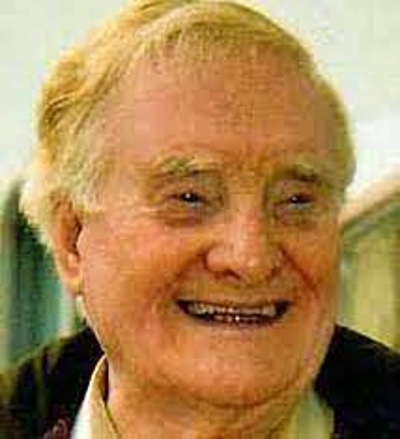
Internationally experienced director, manager, professor. A strategic 'doer' who translates vision into results. Regularly increasing group revenues, profit margins and asset values while maintaining strict controls. Consistently improving clients' and students' projects, research, dissertations, grant applications. A magnetic writer who makes the complex simple. Author of ten business books published by Blackwell, Kogan Page, Heinemann, Pitman & EPB Singapore. Computer literate, "always online" with unequalled turnaround speed. Empathetic disciplinarian developing the best in people.
You can contact Len via his website.
I'd like to thank Len for writing this second post regarding grammar and punctuation for my website. You can read Len's previous post about comma usage here.
Do you have some writing experiences you'd like to share with my readers? If so, please review my submissions guidelines and get in touch.
Alwyn F
Thank you for the articles from Len on commas and quote marks. His instructions as to how to set up your MS Word for your preferred quote marks seems to refer to an older version. For those who might still be searching under <File> the <Autocorrect> tab is now filed under <Tools> and is about halfway down the list.
Chris Fielden
Thanks for sharing that information, Alwyn - much appreciated.
However, I use the most recent version of Word (via a Microsoft 365 subscription), followed Len's instructions and found everything where he said it would be. I don't have a <Tools> option at all anymore... Maybe you're on an older version of Word?
Either way, it's useful to know for people on different versions of the software :)
Alwyn F
Hi Chris. I always keep my MS Word and Microsoft 365 up to date. I'm using the Mac version, are you using the Windows version? Perhaps there are some slight differences.
Chris Fielden
Hi Alwyn. Thanks for your reply - much appreciated. I use Windows, so that is probably the reason for the difference. The joys of technology... :)
Karen GS
Hey Chris, I checked out the article written by Dr Len. It is interesting but confusing as everything he said is used in America (inverted commas, single/ double inverted commas) are actually what we teach in primary school here in the UK. Glad to know we are using it correctly in schools though, even if we do use the technical terms considered American.
Chris Fielden
Thanks for sharing that Karen, that's really interesting. I didn't know that we used American terminology in our schools. Re the actual writing, I think the best advice is whatever you decide to do, be consistent :)
Karen GS
Hehe, I get that. In my writing, I am always checking my grammar and punctuation since I tend to complain about everyone's use of grammar. I like your advice - just be consistent!
Chris Fielden
Thanks Karen :)
Patricia C
Hi Chris, thank you very much for these grammar usage posts.
I echo what Karen GS says about double inverted commas used in British English, having been taught that at school in England, albeit seven decades ago. I have always used them in my writing, thinking that single ones were American style. I have written several stories set in America and have adapted spelling and punctuation accordingly. Oops!
Recently, a friend, who is a professor of English literature, told me that single ones are now becoming acceptable (in the UK) and will give a manuscript a more up to date feel.
Thank you to Len for his very clear explanations and the reasoning behind them, British or American, with examples. - much appreciated.
Chris Fielden
Hi Patricia, thank you for sharing this - much appreciated.
That's really interesting. My experience is mostly with fiction, and what Len says is certainly true of punctuating dialogue. 'In the UK,' said Chris, 'publishers would be present dialogue like this.' Chris took a pause. "But in the USA," he continued, "they would present it like this." But note, all the other punctuation is the same - it's just the quotation marks that are different.
William Shunn has some excellent resources that give examples of manuscript formatting. This is US based formatting. His site is often referenced in fiction magazine / competition submission guidelines.
Let's see if anyone from the US adds a comment about their experiences on this subject matter.
All the best to you :)
Charmian S
Many thanks to Len for the really helpful articles. Also, thank you Chris for your excellent website.
Chris Fielden
Thank you, Charmain, very much appreciated :-)
Leave your comments
Please use the form below to leave your comments. All comments will be reviewed so won't appear on the page instantly. I will not share your details with anyone else. Most recent comments appear at the bottom of the page, oldest at the top.